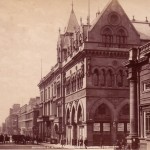 Buchanan Street was named after Andrew Buchanan, a Tobacco Lord, who envisioned that Glasgow would spread westward. With this in mind, on the 15th of February, 1763, he acquired the first portion of “five acres or thereby of ground in the Burgh of Glasgow, in the part called Palezeon’s Croft, on the North side of Argyle Street, with plots or steadings for building on each side thereof “. His plan was to take down his own mansion which was situated on Argyle Street opposite the entrance to St. Enoch Square and thereby enable access to the new street. Unfortunately, the American War of Independence ( 1775-1783 ) intervened and Andrew Buchanan lost his tobacco fortune. His business was wound up and his development plan ended up in the hands of some Glasgow bankers. Yet, in spite of this setback, his vision soon became reality and lots on the street bearing his name were progressively occupied. The first part of Buchanan Street from Argyle Street to Gordon Street was opened in 1780 and the remaining section in 1804. Initially, the street was occupied by a mixture of merchants’ villas, small holdings and some workshops but as the century progressed some very handsome buildings were erected, the first of significance being St George’s Church, now known as St. George’s-Tron Church, designed by William Stark and completed in 1808. Further fine buildings were added, including the Glasgow Stock Exchange in 1875-77, designed by John Burnet. The street acquired a reputation for elegance and specialty shopping which continues to this day.
Buchanan Street was named after Andrew Buchanan, a Tobacco Lord, who envisioned that Glasgow would spread westward. With this in mind, on the 15th of February, 1763, he acquired the first portion of “five acres or thereby of ground in the Burgh of Glasgow, in the part called Palezeon’s Croft, on the North side of Argyle Street, with plots or steadings for building on each side thereof “. His plan was to take down his own mansion which was situated on Argyle Street opposite the entrance to St. Enoch Square and thereby enable access to the new street. Unfortunately, the American War of Independence ( 1775-1783 ) intervened and Andrew Buchanan lost his tobacco fortune. His business was wound up and his development plan ended up in the hands of some Glasgow bankers. Yet, in spite of this setback, his vision soon became reality and lots on the street bearing his name were progressively occupied. The first part of Buchanan Street from Argyle Street to Gordon Street was opened in 1780 and the remaining section in 1804. Initially, the street was occupied by a mixture of merchants’ villas, small holdings and some workshops but as the century progressed some very handsome buildings were erected, the first of significance being St George’s Church, now known as St. George’s-Tron Church, designed by William Stark and completed in 1808. Further fine buildings were added, including the Glasgow Stock Exchange in 1875-77, designed by John Burnet. The street acquired a reputation for elegance and specialty shopping which continues to this day.
Jewellers flank the entrance to Buchanan Street in this view taken around 1912 from the entry to St. Enoch Square. On the left, H. Samuel occupies the ground floor corner of the Stewart & MacDonald building and on the right two jewellers, Robert Scott and Robert Stewart, have premises in the former mansion. Robert Stewart held the distinction of having been appointed Goldsmith, Silversmith and Jeweller to Queen Victoria. These jewellers would set the tone for the upscale nature of much of the business conducted in Buchanan Street. On the immediate right of this photograph at the entrance to St. Enoch Square are the premises of R. W. Forsyth. He owned two stores in Glasgow at the time, the other one being at the corner of Gordon Street and Renfield Street. ( Postcard published by E. A. Schwerdtfeger & Co., London E. C. and printed in Berlin. )
Twenty years have now passed and the jewellers and mansion on the right corner of Buchanan Street have been replaced with the fine Art Deco – inspired building, designed by H. Wilson, R.I. Pierce and N. Martin and completed in 1929. For many years it was occupied by Montague Burton Ltd., the famous tailor and Lithuanian immigrant, who started his company in Chesterfield when he was 18 and built it up to become the largest multiple tailoring business in the World during his lifetime.
It should be noted that tram and bus routes never ran along the main section of Buchanan Street nor did trams enter St. Enoch Square although many bus routes would subsequently terminate there. ( Postcard published by Valentine’s. )
The photographer would have had to set up his tripod close to the tramlines in Argyle Street in order to take this view looking north up Buchanan Street around 1905. Electric lighting has been installed outside the windows of H. Samuel, the jeweller and watchmaker on the corner, so that passers-by could browse the displays after dark. ( Postcard published by B R Ltd. and printed in Saxony. )
We have now crossed Argyle Street and are walking northwards up Buchanan Street. It was in this part, close to the Argyle Street thoroughfare, that many of the larger stores on Buchanan Street were concentrated. On the left is the ladies apparel store and furrier, MacDonald’s, and across the street are Fraser’s followed by the Jaeger wool shop and then Wylie Hill’s. Burton’s is out of the picture to our right. This photograph was taken in the 1930’s and it is interesting to note the trend to lighter colours in some of the shop fronts. ( Postcard published by J. Salmon Ltd., Sevenoaks. )
We have a good view of pedestrians and fine motor cars in this early 1930’s scene. A fashion conscious young lady is standing by the kerbside, perhaps admiring the fine Daimler with the AA badge on the grill. Fraser Sons store is on the right and beyond that is Jaeger House and then Wylie Hill’s. The awning identifies the location of Stuart Cranston’s Tea Rooms. Across the street, Wylie & Lochhead occupy the building with the bay windows. It is interesting to note in this photograph, as in the previous one, that by the 1930’s the lamp standards on Buchanan Street had been removed and the lights were now suspended from wires strung across the street. ( No publisher identified. Card postmarked 28 Feb, 1934 )
The photographer was clearly attracting a lot of interest in this scene, taken around 1910, and showing some of the fine Victorian and Edwardian buildings for which the street is famous. We are looking across to Jaeger’s the wool shop and beyond is Wylie Hill’s with examples of China and house wares in the windows. The building adjacent to it is known as the Argyll Chambers and it includes the Buchanan Street entrance to the famous Argyll Arcade. ( Note the different spelling of Argyll from the street name.) Renowned for jewellery and timepieces, the Arcade was also the location for many years of the Clyde Model Dockyard, a Mecca for modellers and young boys with dreams. Near the entrance to the Arcade is the signage for Stuart Cranston’s Tea Rooms. Stuart Cranston, a tea dealer, is credited with opening the first tea room in Glasgow in 1875, reportedly the first in the world. He certainly made a great contribution to the social life of the city. ( Postcard made in France, publisher unknown. )
This picture was probably taken in 1912-14, a few years after the previous one. Edwardian dress is still in vogue but there are now more motor vehicles in evidence. The globes enclosing the electric street lights have been replaced and a rider has been attached to Stuart Cranston’s Tea Room sign that reads Fruitarian Snack & Lunch Rooms. It is interesting that such a strict branch of vegetarianism should have been popular at the time. There was clearly a movement to promote healthy eating and also abstinence from alcoholic drinks. Several temperance hotels were present in the city, including the Waverley, which used to be further up Buchanan Street before the business was relocated to premises in Sauchiehall Street. It was Robert Cranston, the cousin of Stuart Cranston’s father, who founded the temperance hotels. ( Reliable Series printed postcard, published by W. R. & S., William Ritchie & Sons. )
This early photograph of Buchanan Street was taken around the early 1880’s and on the left is part of the recently completed Stewart and MacDonald warehouse designed by William Spence c. 1879. This fine building displays many decorative features including carved reliefs, ornamental balustrades and Corinthian pilasters, visible on the upper levels. Thomas Murray & Son, Booksellers and Stationers are located on the ground floor and in the warehouse next door is the business of David Kemp & Son. Beyond that is the new Wylie & Lochhead building, designed in three sections by James Sellars and replacing the original building on that site which was destroyed by fire in 1883. The windows on the second and third floors of the first and third sections would subsequently be modified by the addition of bay fronts. These are gaslight days and several different types of lamp are visible including a row of globes outside the premises on the right that would be replaced by a new building in 1888/89, to be occupied by Wylie Hill.
There is a real sense of movement in this 1920’s scene as people are walking, some more briskly than others, on the broad pavement past the frontage of Jaeger’s and Wylie Hill’s. Perhaps for many, the sign advertising Stuart Cranston’s tearoom in the Argyll Arcade would be a welcome sight. One man walking towards the camera is dressed in Plus Fours, where the trousers were gathered in at the knees and extended four inches below, hence the name. They were very popular as sporting attire at the time and often paired with diamond-patterned Argyle stockings. I have seen an example of this postcard postmarked 20th September, 1927. ( Publisher unknown )
We have now moved slightly further up Buchanan Street but back in time because the Argyll Chambers had not yet been built when this photograph was taken and, instead, and there is a two-story building with globes outside and a white flagpole. This was the mansion of John Reid who, inspired by European arcades, decided to start one of his own. He moved his family upstairs and set up the Argyll Arcade on the ground floor and continued it beyond the rear of his home and round to the right, through a tenement building that he owned on Argyle Street, hence the angled arcade. Stuart Cranston had a tearoom in the front of John Reid’s original house and this carried over into the new arcade when the Argyll Chambers were built between 1902 and 1904. It seems that the globes indicating the Argyll Arcade were also retained. On the other side of the street was Wylie & Lochhead’s store that specialized in furniture and carpets. ( Postcard published by J.M. Co., Caledonia Series, printed in Germany. )
Here is another view of John Reid’s mansion taken around 1900 before it was replaced by the Argyll Chambers. Outside, the globes are advertising the Argyll Arcade and Stuart Cranston’s Tea Room. The “covered wagon” parked in front of Wylie Hill’s is their delivery vehicle. ( This photograph is courtesy of the Graham Lappin Collection. )
We are now drawing close to John Reid’s mansion with Stuart Cranston’s Tea Rooms clearly indicated. Across the street is Wylie & Lochhead’s store. Notice the horse-drawn cabs with their top-hatted drivers. The only way to gain access to the shops in this part of Buchanan Street was either by cab or by walking as the tramway never ran along Buchanan Street. The Glasgow District Subway System ran underneath the length of Buchanan Street and the nearest stations were further up the street and in St. Enoch Square where they still are located today. ( Postcard publisher unknown ).
This photograph shows Wylie Hill’s store on the right with their window displays filled and next door is the recently built Argyll Chambers complete with statuary attributed to James Milne Sherriff. The architectural features of both buildings are particularly fine with the Wylie Hill building displaying an abundance of Corinthian pilasters and the Argyll Chambers featuring full Corinthian columns. An example of this postcard was postmarked DEC 9 07 so we know that the photograph was taken no later than 1907. ( Postcard published by Davidson Brothers, London )
We have now passed Wylie & Lochhead’s and the building with the high arched entry on the left, designed by Campbell Douglas and James Sellars in 1879, is occupied by the Glasgow Herald. This is a very fine building with carvings in relief on either side of the arch and Corinthian columns and pilasters rising through the first and second floors. In this 1920’s scene, passers-by are stopping to read headlines posted in the windows. Further up on the left is the Walk-Over Shoe store which would be a fixture for many years as would be Thomas Cook & Son’s Tourist Office and Bureau de Change on the other side of the lane. The sign on the lamp post is urging pedestrians to keep to the left. ( Publisher unknown )
In this scene, also from the 1920’s, the travel agency of Thomas Cook & Son is on the left of the picture, followed by the furniture store of John Reid & Son and then a curious, rather narrow building, Flemish in appearance with a steep pitched roof at right angles to the others. This property was designed by the Edinburgh-based architect George Washington Browne and completed in 1897 for Miss Kate Cranston’s Tea and Luncheon Rooms. Miss Cranston also commissioned Glasgow’s two most innovative designers, Charles Rennie Mackintosh and George Walton, to produce the interior decor and furnishings. Her business continued at that location until 1918 when the premises were occupied by a branch of the Clydesdale Bank, as shown in this photograph. Adjacent to the bank is Ciro Pearls, a very successful retailer still trading internationally, and next door is Fuller’s, a worthy successor to Kate Cranston’s and popular for teas, coffee, cakes and their own brand of chocolate. They also had an entrance in Gordon Street. The large pair of spectacles indicates the location of John Lizars, the renowned optical and photographic specialist. The firm continues in business today as Black & Lizars. ( Published by J. M. & Co. Ltd., Caledonia Series, printed in Saxony. )
This postcard is dated 25th July, 1910 and is published by William Ritchie and Sons, Ltd. ( WR&S ) in their Reliable Series.
As we continue our walk up Buchanan Street, a group of ladies in this Edwardian scene is looking at jewellery and decorative items in the windows of W. & W. Logan beside the Kodak sign. Hope Brothers, the outfitter, is adjacent, shaded by awnings, and beyond is the entrance to South Exchange Place that leads into Royal Exchange Square. On the opposite side of Buchanan Street, part of Lizars store is visible, followed by Manson’s, and Alexander & Son, before we come to Henry Burton & Co. the glover on the corner with Gordon Street. In this photograph, the resolution is such that tower and clock of St. George’s Church much further up the street can be clearly discerned. It is interesting to note the broad-rimmed extravagant hats with floral embellishments featured in this photograph that were so popular with ladies in the Edwardian era, a fashion that would soon change so radically. ( Postcard published by Judges, Ltd., Hastings. )
The fine Baroque-inspired building on the opposite corner of Gordon Street with Buchanan Street was designed by Sydney Mitchell and George Wilson and dates from 1887. At the time the photograph was taken, it was occupied by a branch of the Commercial Bank of Scotland. On the right hand side of Buchanan Street, some gentlemen have paused to look in the windows of Hope Brothers, while the man in the foreground observing the photographer appears to be carrying a cello bow. The city had recently invested in the installation of electric street lighting and used the opportunity to combine the new technology with an artistic flourish in the form of ornate standards with a wrought iron motif. In the middle of the street there is a standard bearing two lamps, a rare sight and indicative of the importance of this location. ( Publisher unknown. )
Virtually all postcard views of Buchanan Street are taken looking north, up the street. This Castle Series card is an exception and the view is directed south toward St. Enoch Square and St. Enoch Church in the distance. The rising hemlines in the ladies’ fashions point to the post-Edwardian era. Fuller’s, on the right in the picture at 99 Buchanan Street, opened in 1914. Judging from the sombre frontage of the Flemish-styled building at number 91, Kate Cranston had probably already closed her Tea and Luncheon Rooms there in 1918. Otherwise, there would have undoubtedly been some signage. There are no motorized vehicles on the street and they did not become evident until the 1920’s so the postcard probably dates from around 1919. This view was clearly taken before St. Enoch Church was demolished in 1926. It is interesting to note than men’s fashion has not changed all that much in the intervening period except that we have dispensed with hats, whereas women’s fashions have undergone many transformations.
We have now passed the junction with Gordon Street and are approaching St. Vincent Street on the left and St. Vincent Place on the right. There is a rather fine building in the foreground with an abundance of Corinthian columns and a balustrade spanning the frontage. On the right is a branch of Saxone & Sorosis Shoes which was the company’s original name, before it was shortened to Saxone. Their fine product was made in Scotland. Beyond St. Vincent Street is the Western Club building designed in the style of an Italian palazzo by David Hamilton and his son James, and completed in 1841. David Hamilton (1768-1843) is regarded as the founding father of Glasgow architecture. In this view, the buildings are obviously blackened by soot from heavy industrial pollution and they were radically transformed by surface cleaning several decades later when the original stone colour and much of the finer detail was exposed.
In this scene, we are looking at the intersection of Buchanan Street with St. Vincent Street on the left and with St. Vincent Place on the right. This photograph was taken shortly after 1900 and traffic in those days was generally sparse and slow. The fastest vehicles would be the newly electrified tramcars which crossed Buchanan Street at this location. On the left beyond the intersection are three very fine buildings in a row; the Western Club ( David and James Hamilton, 1840-41 ), the Stock Exchange ( John Burnet, 1875-77 ) and St. George’s Church ( William Stark, 1807-8 ), all of which survive to this day, albeit with extensive internal remodeling. On the right-hand side of the photograph are Queen’s Buildings and above Cairns’ Bar on the corner is the Glasgow office of the Smith Premier Typewriter Company of Syracuse, New York. The signage in the window proclaims the Grand Prix award bestowed upon the company for their Premier typewriter at the 1900 Paris Exposition. These typewriters represented the cutting edge in office equipment at the time. ( Postcard by Davidson Real Photographic Series )
In the centre of this view, a man wearing a straw boater is crossing the street and heading towards the building with signage that refers to the Paris Grand Prix of 1900. As well as introducing a new century, 1900 was an especially important year for Paris because the city hosted both the World Fair and the Summer Olympic Games. Glasgow would host its second International Exhibition in the following year. As we look up Buchanan Street, East George Lane separates the buildings on the right and the next intersection is West George Street. In the distance, as the incline increases, Buchanan Street takes a turn to the left and the taller building at the top housed the famous Armstrong’s Hotel at number 244 which afforded views both down Buchanan Street and also along Sauchiehall Street. The hotel sold modified versions of this postcard to advertise its location.
In this scene, we have come further up Buchanan Street past the Western Club and are now looking at the recently completed Glasgow Stock Exchange building, designed in a Gothic Venetian style by John Burnet Sr. and erected at the corner of Buchanan Street and St. George’s Place between 1875 and 1877. An extension to this building would later be added in St. George’s Place in 1906. This photograph, taken by George Washington Wilson around 1880, shows the view looking down Buchanan Street with the gas lamps, horse-drawn traffic and the steeple of St. Enoch Church visible in the distance. Advertisements posted on the Stock Exchange by Edgar’s, the licensed grocer, announce “New Season’s Teas”, “Fresh Ground Coffee” and “Light Summer Clarets”. Described as “Stores for the Moors”, they would appeal to the wealthy who would either own grouse moors or frequent them during the summer season. Edgar’s would be stocking the hampers ready for loading onto the MacBrayne steamer R.M.S. Columba at the Broomielaw, for shipment to the hunting lodges and hotels of the Western Highlands. On the far right of the photograph is part of William Stark’s St. George’s Church, built in 1808 when the upper section of Buchanan Street was being developed. Now known as St. George’s Tron Church, it is still very active, holding worship services every Sunday and Wednesday and engaging in community outreach.
This photograph is taken from further up Buchanan Street, near the top of the incline and close to the intersection with Cathedral Street. The view is looking south down the street with St. George’s Church visible on the right and beyond that, the Western Club. The new Stock Exchange has not yet been built, so this view predates 1875. Nearer the camera on the right is the Waverley Temperance Hotel, opened in 1840 and one of several temperance hotels that were springing up in the city where intoxicating drinks were not permitted on the premises. In the foreground on both sides of the street are commercial buildings and warehouses. On the left is George Cameron, Publisher & Wholesale Stationer, and on the right are Chalmers & Tosh, Tin and Zinc Packing Case Makers, and McLelland & Dickson, Upholsterers and Furnishers. Retail sales were concentrated at the south end of Buchanan Street and manufacturing and wholesaling at the north end. All the premises in this photograph appear to be closed and there is not a person or carriage in sight, so the scene was probably photographed early on a Sunday morning. ( Photograph courtesy of the Graham Lappin Collection. )
Buchanan Street Railway Station as seen circa 1925-1930 when it was owned and operated by the London, Midland & Scottish Railway ( LMS ). Constructed in 1849 by the Caledonian Railway Company, it would serve as that railway’s main terminus in Glasgow until Central Station was built.
Buchanan Street Redevelopment
The north end of Buchanan Street has been extensively redeveloped since 1950. It used to angle towards the left at the top and the section intruding from the right was the block between Cathedral Street and Parliamentary Road. Properties there were demolished in the early 1950’s to make way for the N.A.A.F.I Building ( Navy, Army and Air Force Institutes ) which provided facilities and goods to British servicemen and their families. Some photos of the building are posted in a discussion thread on the excellent Urban Glasgow website http://urbanglasgow.co.uk/archive/people-and-places-discussion-thread__o_t__t_1039.html The N.A.A.F.I. was not in operation for long before it was taken over by the Reo Stakis organization in 1964 and turned into a casino. During the late 1970’s, the construction of Buchanan Street Bus Station resulted in a rearrangement of roads in the area. The western part of Parliamentary Road was realigned in an approximate east-west direction between North Hanover Street and West Nile Street and was renamed Killermont Street. The buildings along the eastern part of Parliamentary Road were cleared to make way for a new council housing development. As for the casino, it was reported to be still standing in 1985, but was subsequently removed to allow construction of the Glasgow International Concert Hall which was completed in 1990 and renamed the Glasgow Royal Concert Hall upon the granting of Royal Status. The Buchanan Galleries development came later, Buchanan Street was straightened out and the mall built over Cathedral Street. The Galleries opened to the public on 31 March, 1999. During this collective redevelopment, the area that used to be occupied by the western part of Parliamentary Road was built over.
Legends © Christopher J. Jones
Except where otherwise stated, all photographs are from the author’s collection.
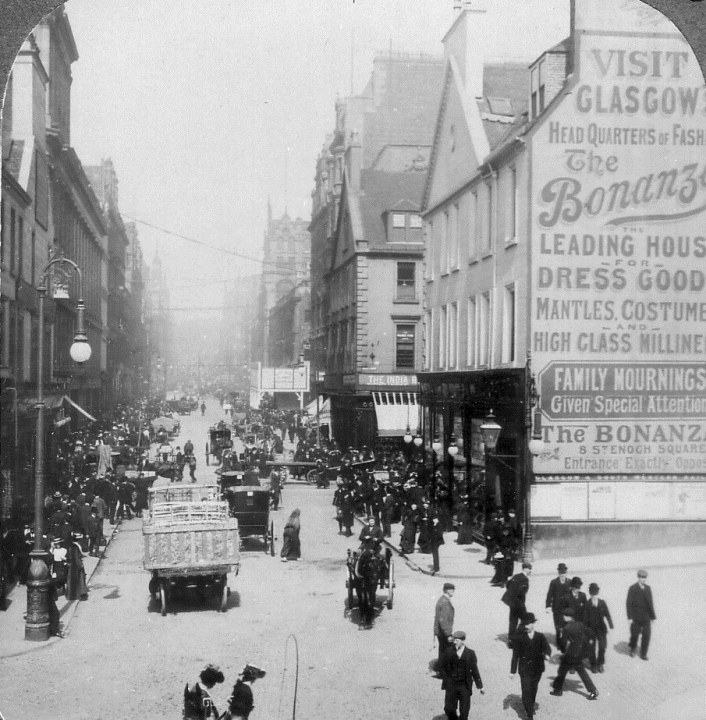
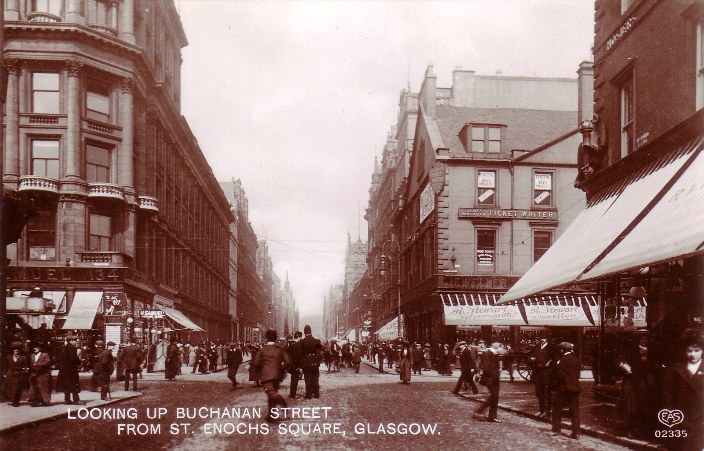
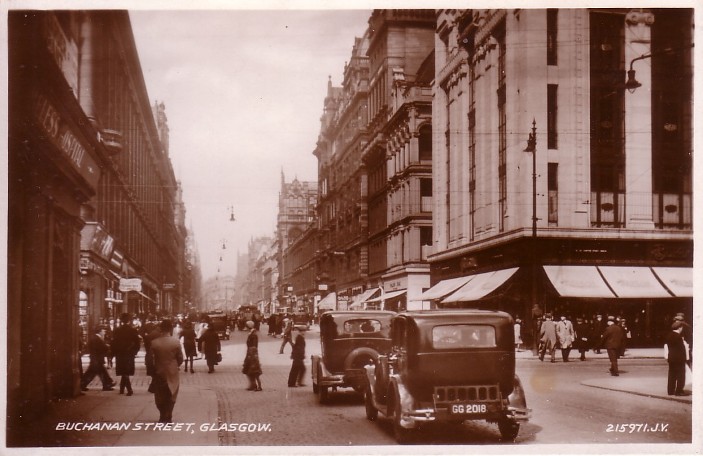
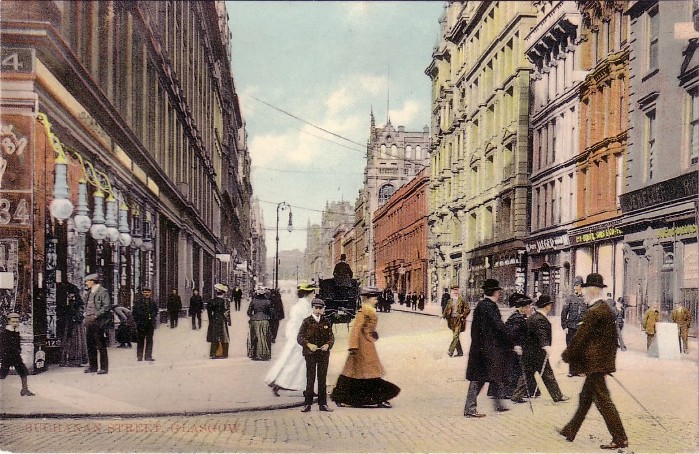
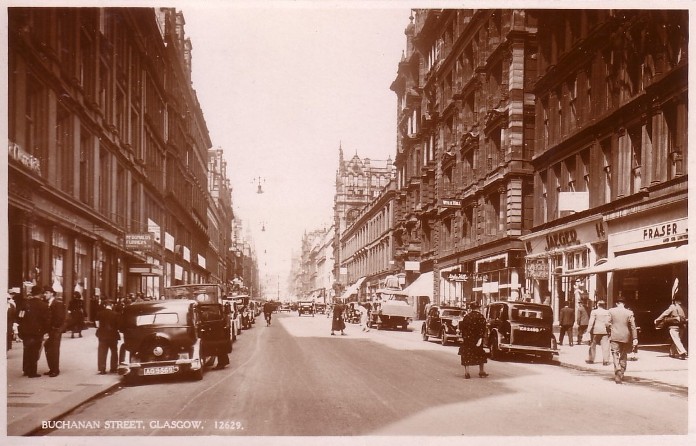
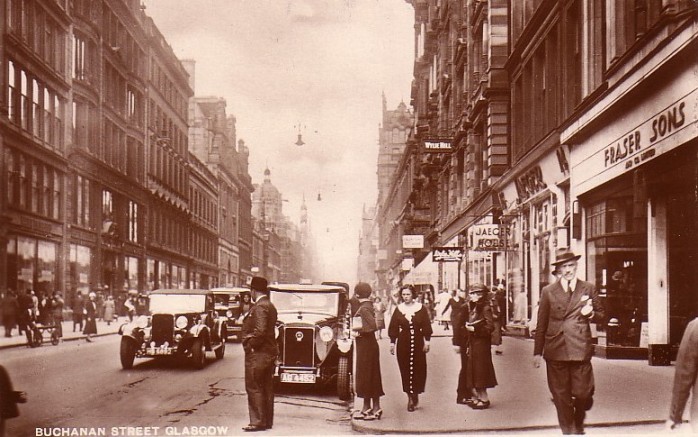
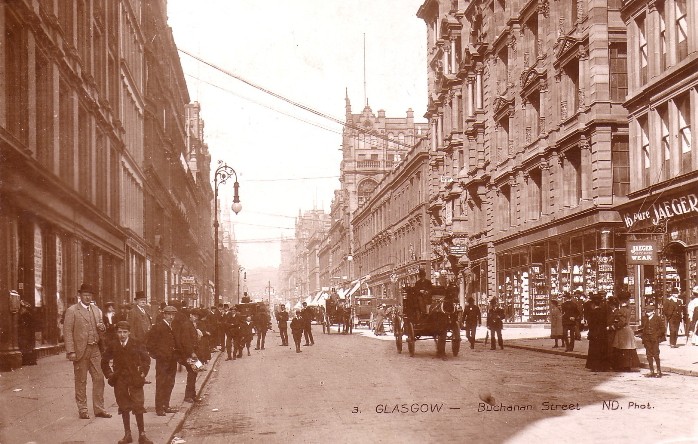
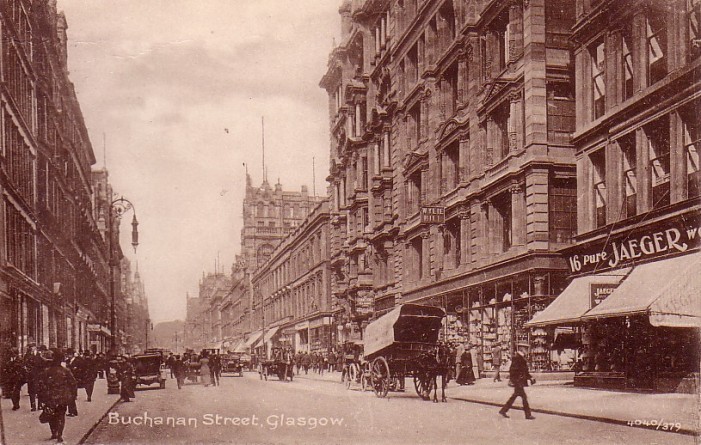
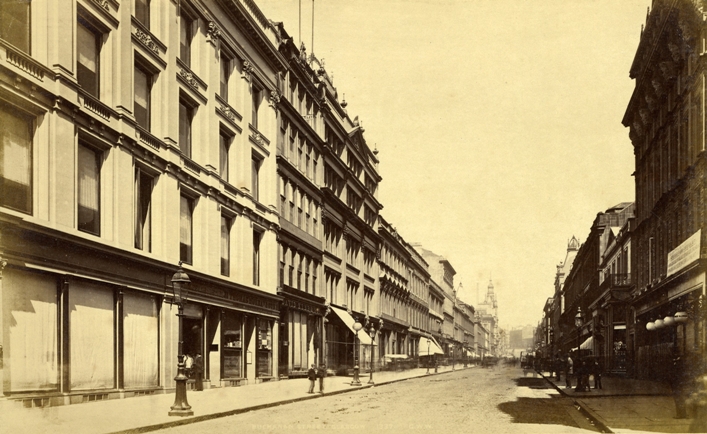
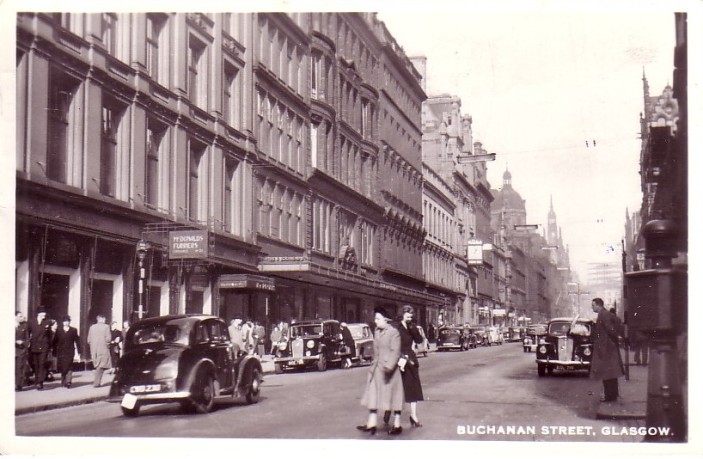
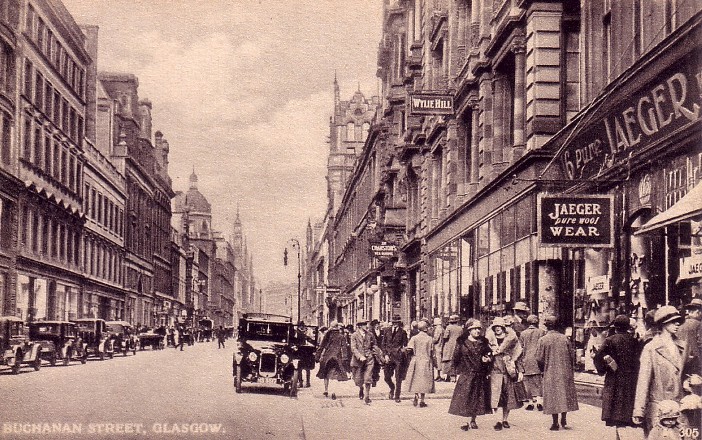
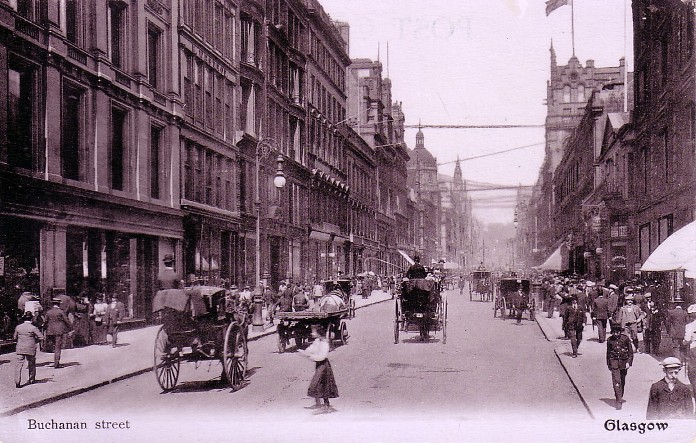
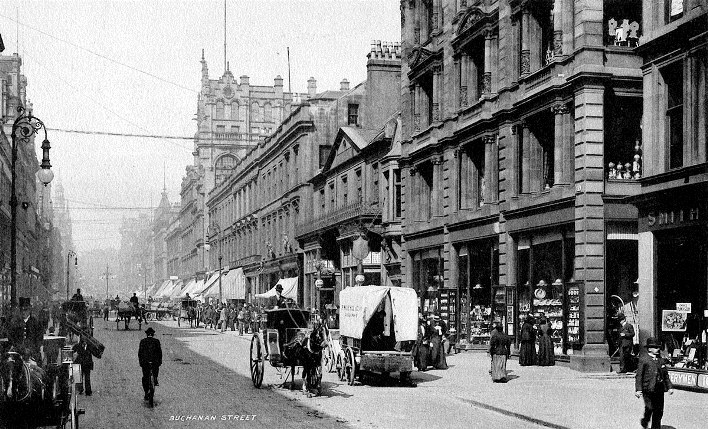
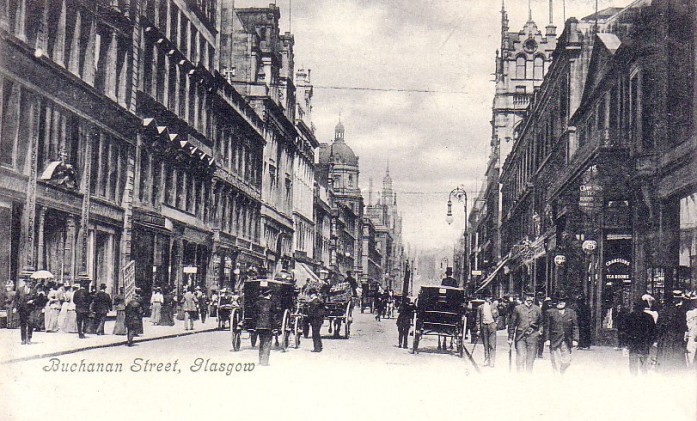
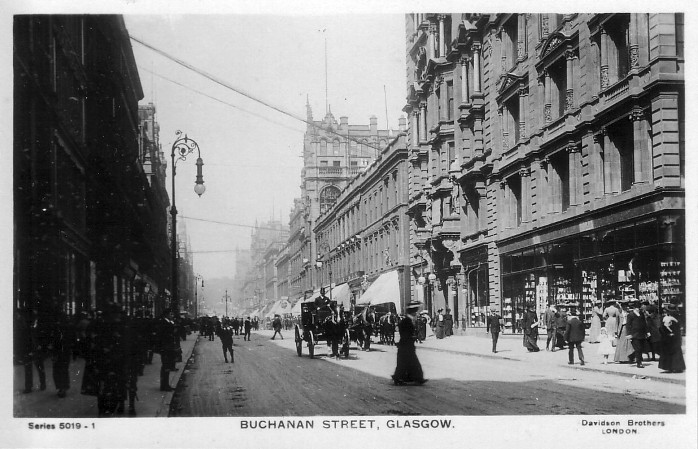
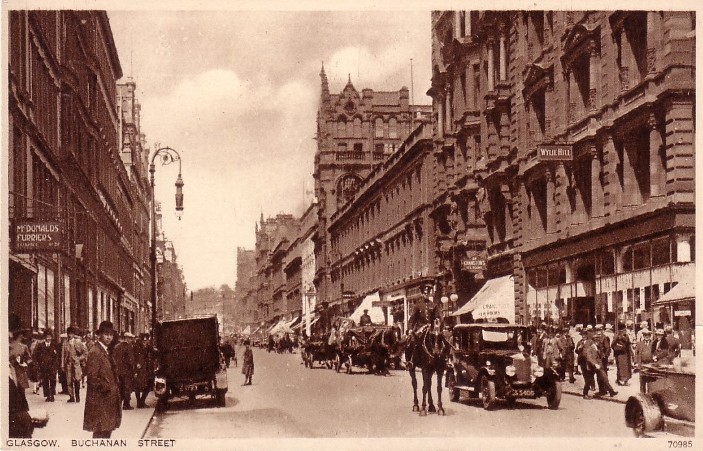
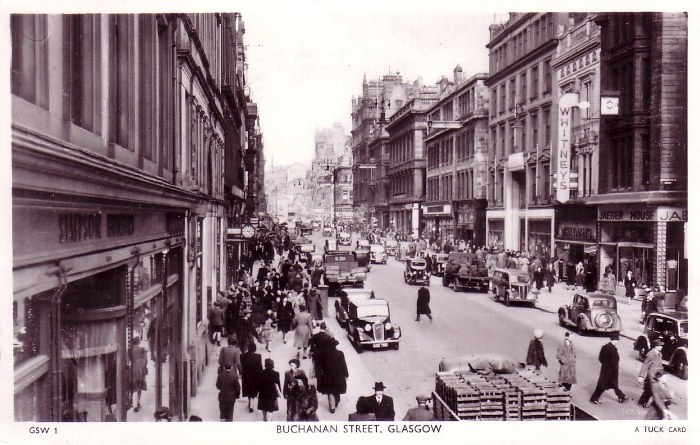
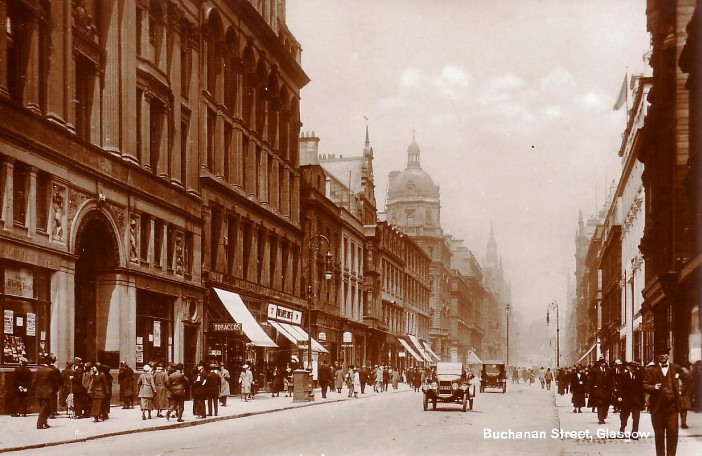
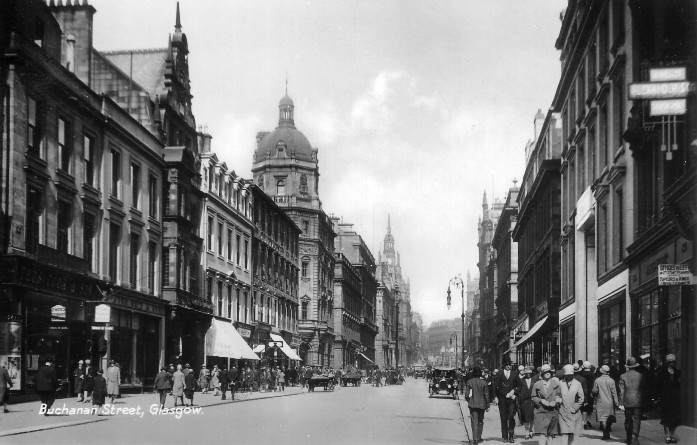
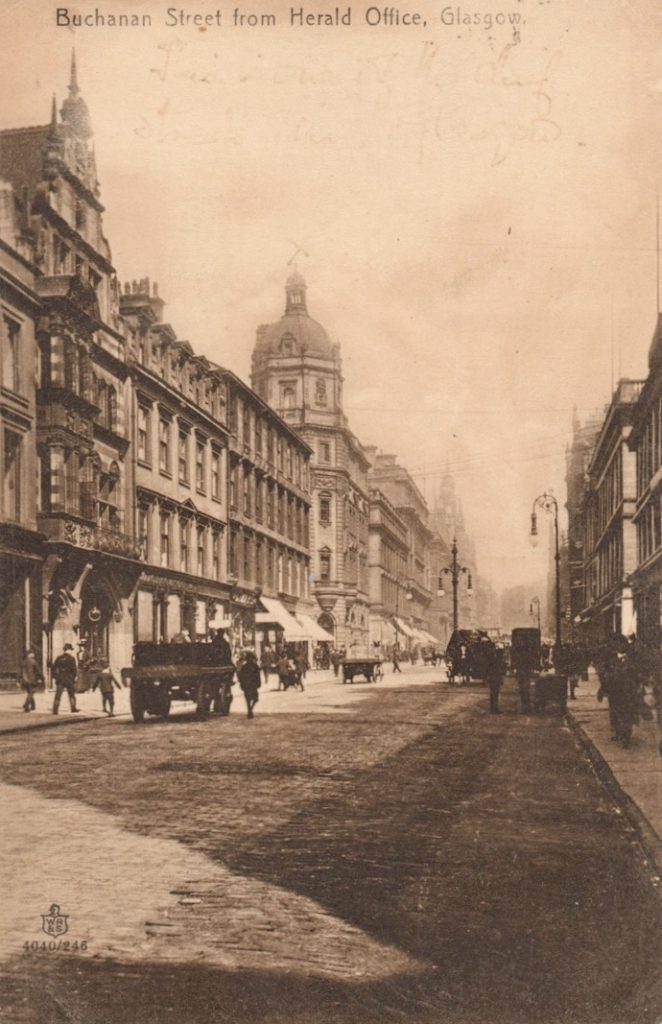
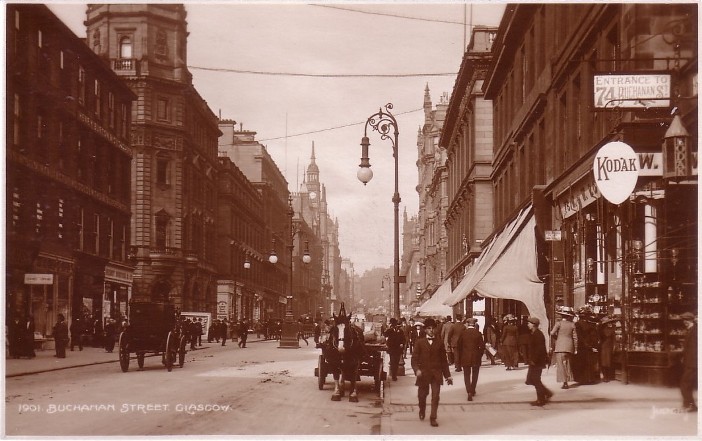
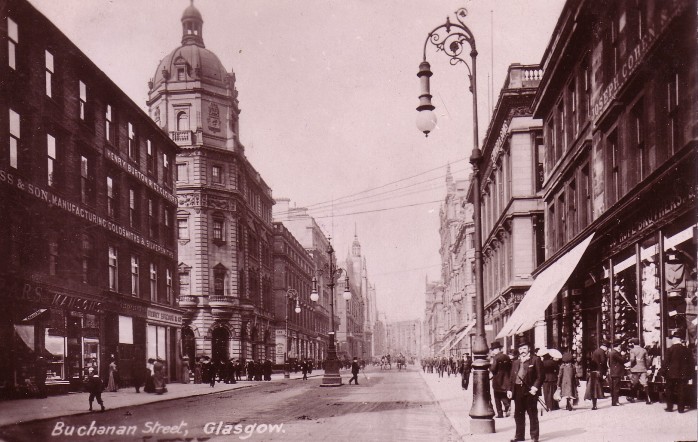
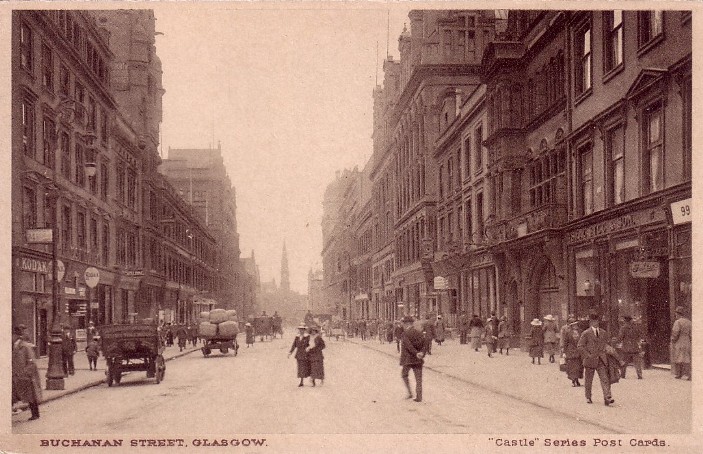
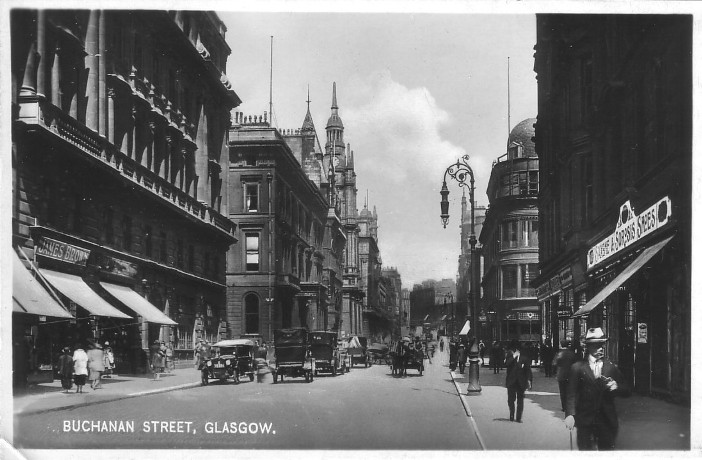
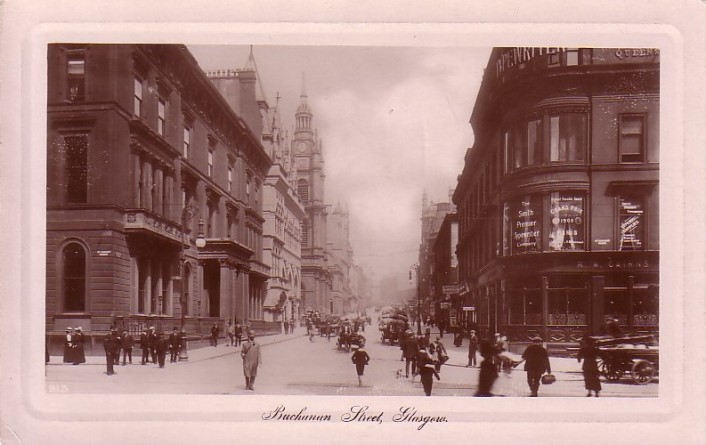
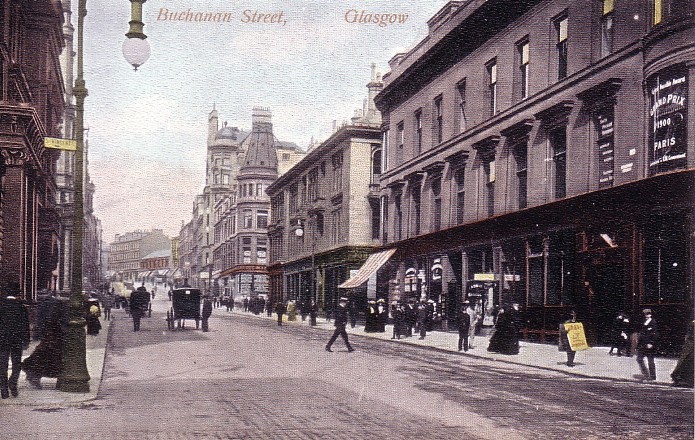
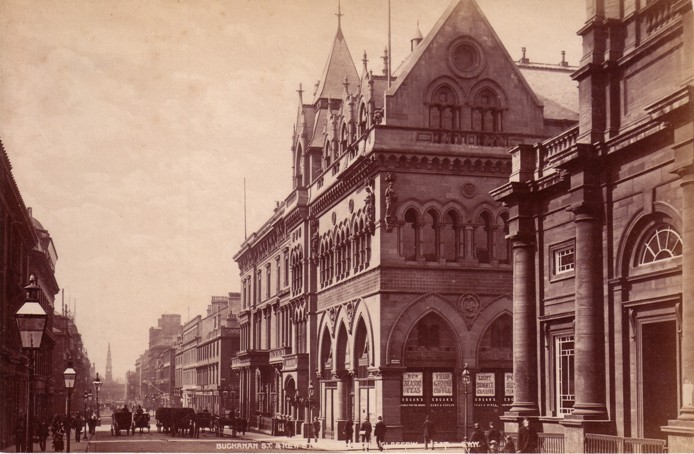
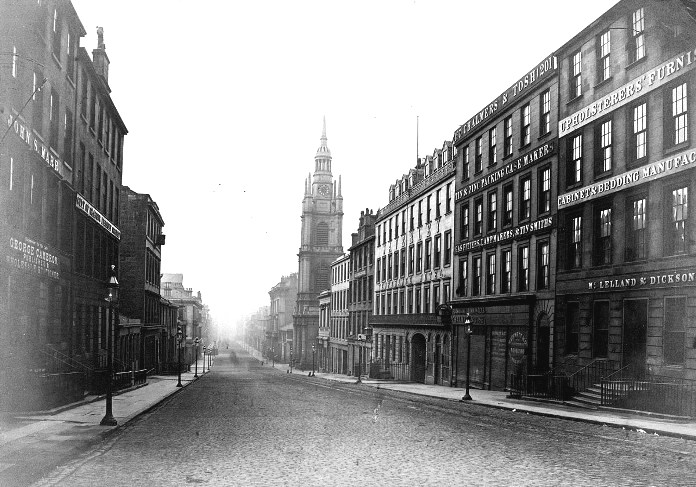
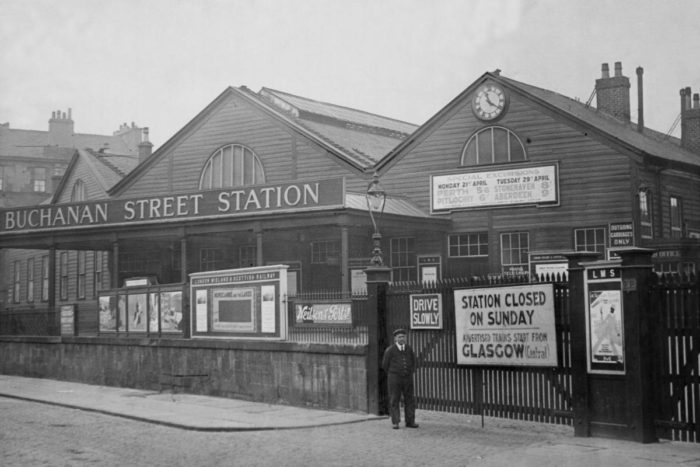

{ 4 comments… read them below or add one }
← Previous Comments
Hello Chris,
There was a triangular building at 289 Buchanan Street, north of Renfrew Street. The ground floor was a retailer of surgical supplies, and the top two floors were occupied by a Wholesale Stationer, Hector Morrison & Son Ltd. This firm was founded by my grandfather, and they served the whole of Scotland. In the late sixties the firm relocated to Bridgeton and the building was demolished as part of the development of that area. The business no longer exists, like most wholesalers.
Hector
Hello Hector,
Thank you for sharing this important part of your family history. I looked at some aerial photographs of the top of Buchanan Street before it was redeveloped and there was a triangular building situated in the gushet just below the junction with West Nile Street. Perhaps this was the building.
Best wishes,
Chris
Hello Chris,
I may have made this request before. I am publishing a book, a biography of David Stewart Dawson (1849-1932) who made a fortune selling watches and jewellery. He was born in Cairnie, Aberdeenshire but moved to Glasgow as a teenager, where he worked as a draper’s salesman. His regular ‘patch’ was Buchanan Street and I’d like to use one of your photos to illustrate the book. May I have permission to use the postcard tagged “Buchanan Street near the Reid Mansion, Glasgow 1”? I need to be sure there is no copyright infringement.
Regards and thanks for an excellent website.
Geoff Nadin
Hello Geoff,
Thank you for your request and I believe that this is the first time I have received it. The Buchanan Street photo to which you refer was provided to me by Graham Lappin. It is well out of copyright and you should be fine crediting the website and the Graham Lappin Collection as your sources.
With best wishes,
Chris